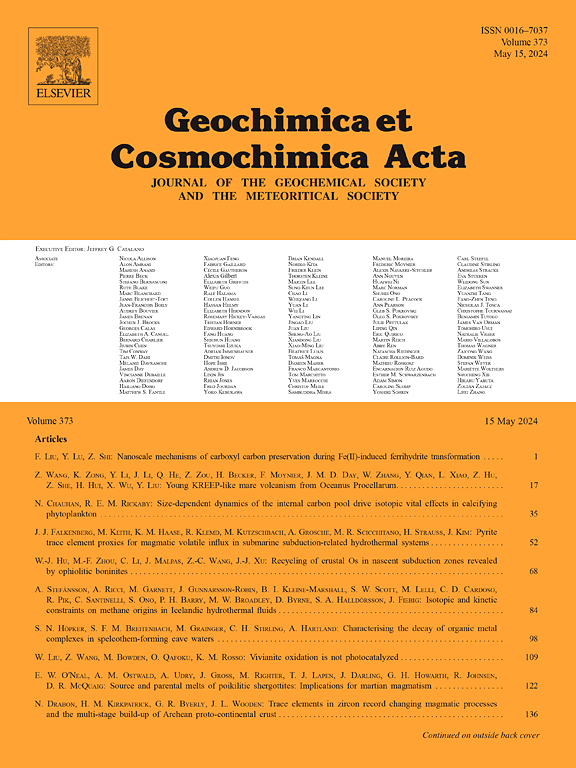硼钛矿/有机化合物界面上的电子转移:结构重排和分解的机制、调控和两阶段动力学差异
IF 5
1区 地球科学
Q1 GEOCHEMISTRY & GEOPHYSICS
引用次数: 0
摘要
锰和碳在不同环境条件下的耦合循环中,铍锡矿和有机化合物(OC)之间的电子转移起主导作用。虽然以前的研究广泛地研究了界面Mn还原,表面Mn2+吸附和表面到内部电子转移的单个过程,但这些反应之间的动态相互作用以及调节表面和内部Mn状态细微变化的机制仍然知之甚少。此外,现有的模型没有充分捕捉到pH、Mn2+浓度、电子供体类型等多变量系统中的电子转移动力学。本研究以甲酸(HCOOH)、甲醛(HCHO)和甲醇(CH3OH)三种典型OC为研究对象,研究了多种环境变量影响下铋矿的还原动力学。时间序列分析显示,固体中Mn平均氧化态(AMOS)的变化与铍锡还原溶解释放Mn2+之间存在动力学差异和时间滞后,表明铍锡与OC界面发生了两阶段的电子转移机制。x射线吸收精细结构光谱显示,初始阶段共角MnO6八面体快速增加,AMOS下降,随后AMOS略有下降,大量矿物溶解释放Mn2+。软x射线吸收光谱和密度泛函理论计算证实,两个阶段之间的过渡点主要受pH调节下表面MnII浓度的影响。在此基础上,利用机器学习框架(JAX)模拟了pH、Mn2+浓度和OC类型对吸附平衡和电子传递速率的影响。HCHO的吸附平衡常数比HCOOH低一个数量级,但由于较高的电子转移速率,反应速度更快。pH和Mn2+浓度对OC和Mn2+在活性位点上的竞争吸附均有影响。结合这些参数,我们创建了一个三维表面图,综合考虑了不同元素反应之间的相互作用,包括竞争吸附和氧化还原反应速率,从而可视化了多变量系统中的动力学调节机制。此外,还建立了一个综合的碳化硅还原速率方程,用于预测碳化硅在自然环境中的行为。在结构分解或溶解前的电子存储容量为2.7×1023电子/mol Mn,我们认为铋矿可以作为驱动隐元素生物地球化学循环的地理电池。我们的研究结果还表明,铋矿的高可逆氧化还原活性和多步电子转移反应的动力学差异使其能够促进OC,阳光和微生物之间的能量转换,跨越各种时间和空间尺度。本文章由计算机程序翻译,如有差异,请以英文原文为准。
Electron transfer at birnessite/organic compound interfaces: mechanism, regulation, and two-stage kinetic discrepancy in structural rearrangement and decomposition
Electron transfer between birnessite and organic compounds (OC) plays a dominant role in the coupling cycle of manganese (Mn) and carbon across diverse environmental settings. While previous studies have extensively investigated individual processes of interface Mn reduction, surface Mn2+ adsorption, and surface-to-interior electron transfer, the dynamic interplay among these reactions and the mechanisms regulating subtle changes in surface and interior Mn states remained poorly understood. Additionally, existing models have not adequately captured electron transfer kinetics in multivariable systems involving pH, Mn2+ concentration, electron donor type, etc. In this study, we investigated the reduction kinetics of birnessite under the influence of multiple environmental variables by employing three typical OC: formic acid (HCOOH), formaldehyde (HCHO), and methanol (CH3OH). Time-series analysis revealed kinetic discrepancy and time lag between the alteration of the average Mn oxidation state (AMOS) within the solid and the release of Mn2+ from the reductive dissolution of birnessite, indicating a two-stage electron transfer mechanism occurring at the interface between birnessite and OC. X-ray absorption fine structure spectra revealed a rapid increase in corner-sharing MnO6 octahedra and a decline in AMOS during the initial stage, followed by a slight decrease in AMOS and substantial mineral dissolution to release Mn2+ in the subsequent stage. The transition point between the two stages is primarily influenced by the concentration of surface MnII under pH regulation, as confirmed by soft X-ray absorption spectroscopy and density functional theory calculations. Based on these findings, the adsorption equilibrium and electron transfer rate were modeled by a machine learning framework (JAX), which is influenced by three main factors: pH, Mn2+ concentration, and OC types. The adsorption equilibrium constant for HCHO was one order of magnitude lower than for HCOOH, yet displayed a faster reaction rate due to higher electron transfer rates. Competitive adsorption of OC and Mn2+ on reactive sites was influenced by both pH and Mn2+ concentrations. Combining these parameters, we created a 3D surface plot that comprehensively considered the interplay between different elementary reactions, including competitive adsorption and redox reaction rates, thereby visualizing the kinetic regulation mechanisms in multivariable systems. Furthermore, a comprehensive rate equation for the reduction of birnessite by OC was developed to predict its behavior in natural settings. With an electron storage capacity of 2.7×1023 electrons/mol Mn before structural decomposition or dissolution, we propose that birnessite can act as a geobattery driving cryptic elemental biogeochemical cycling. Our findings also suggest that the highly reversible redox reactivity of birnessite and the kinetics discrepancy in multi-step electron transfer reactions enable it to facilitate energy conversion among OC, sunlight, and microbes across a variety of temporal and spatial scales.
求助全文
通过发布文献求助,成功后即可免费获取论文全文。
去求助
来源期刊

Geochimica et Cosmochimica Acta
地学-地球化学与地球物理
CiteScore
9.60
自引率
14.00%
发文量
437
审稿时长
6 months
期刊介绍:
Geochimica et Cosmochimica Acta publishes research papers in a wide range of subjects in terrestrial geochemistry, meteoritics, and planetary geochemistry. The scope of the journal includes:
1). Physical chemistry of gases, aqueous solutions, glasses, and crystalline solids
2). Igneous and metamorphic petrology
3). Chemical processes in the atmosphere, hydrosphere, biosphere, and lithosphere of the Earth
4). Organic geochemistry
5). Isotope geochemistry
6). Meteoritics and meteorite impacts
7). Lunar science; and
8). Planetary geochemistry.
 求助内容:
求助内容: 应助结果提醒方式:
应助结果提醒方式:


